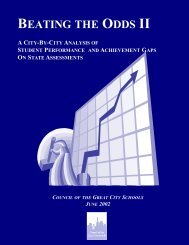WHAT IS ARKANSAS DOING TO CLOSE THE ACHIEVEMENT GAP?
WHAT IS ARKANSAS DOING TO CLOSE THE ACHIEVEMENT GAP?
WHAT IS ARKANSAS DOING TO CLOSE THE ACHIEVEMENT GAP?
You also want an ePaper? Increase the reach of your titles
YUMPU automatically turns print PDFs into web optimized ePapers that Google loves.
Recovery. Both non-program groups started the year at much<br />
higher levels of achievement than the treatment group, but<br />
by the end of the year the Reading Recovery group had either<br />
closed or nearly closed the achievement gap (UALR University<br />
Training Center 2006).<br />
Other Notable Programs<br />
Direct Instruction is designed to accelerate the learning of<br />
at-risk students in grades K-6 using scripted lesson plans that<br />
have been heavily written, tested, rewritten and retested. This<br />
allows the program to be implemented at a rapid pace, with<br />
90% of students typically grasping the lessons after they are<br />
first introduced. Skills are taught in sequence until students<br />
have fully internalized them. In addition, in-class coaches are<br />
used for implementation support. Akin to Success for All,<br />
common periods for math and reading are established so that<br />
students can be grouped based on performance level. Although<br />
not proven by rigorous, randomized control trials, increases<br />
in reading and language scores were dramatic. A nationwide<br />
study of DI found that students’ language test scores increased<br />
between +.49 and +.84 standard deviations, reading scores<br />
increased between .07 and .69 standard deviations, and math<br />
scores increased between .57 and 1.11 standard deviations. 23<br />
Costs range from $150 to $200 per student per year (American<br />
Federation of Teachers 1997).<br />
A third promising program is Core Knowledge, which<br />
includes lessons in math, arts, and world civilizations, in<br />
addition to reading and language. The program introduces<br />
students to interesting yet demanding subject matter at an early<br />
grade level so that low-income students are not left behind in<br />
the early, formative years. Grade-to-grade content guidelines<br />
are given to all teachers, creating a common core. The program,<br />
already in use in West Helena, Clarendon, and Lepanto, has<br />
seen students gain 12 Normal Curve Equivalent (NCE) points<br />
in a year, compared with students in comparable schools<br />
(American Federation of Teachers 1997). 2324<br />
Curriculum and Instructional<br />
Programs in Arkansas<br />
Arkansas has been recognized as a leader in setting rigorous<br />
learning standards. In a study that compares the rigor of<br />
Arkansas’ Benchmark Exam standards to the standard set<br />
by the “Nation’s Report Card,” the National Assessment of<br />
23 1 standard deviation is a very large effect, equivalent<br />
to four years learning on the National Assessment of<br />
Educational Progress (NAEP) test as well as against the size<br />
of the black-white achievement gap.<br />
24 A gain of 20 NCE points is roughly equal to 1 standard<br />
deviation.<br />
Educational Progress, Arkansas ranked in the top ten states<br />
(Peterson and Hess 2006). Arkansas was the second state in the<br />
nation to require four years of mathematics through Algebra II<br />
through the Smart Core initiative. Finally, Arkansas will require<br />
that all high schools offer Advanced Placement (AP) classes<br />
in math, English, science, and social studies by the 2008-09<br />
school year. The state pays for AP exams, and participation rates<br />
in AP courses and exams have sharply increased. Many of the<br />
new participants have been minority and low-income children.<br />
Arkansas has also taken advantage of the federal Reading<br />
First funds to create a state-developed initiative for funding<br />
early reading curricular programs for schools with low<br />
achievement levels. Reading First has a strict set of guidelines<br />
that must be met for local schools and districts to receive<br />
funding. With a little tweaking and the addition of a few<br />
extra curricular components, Success for All, Comprehensive<br />
Literacy, Direct Instruction, and Core Knowledge all qualify<br />
for Reading First funding (Arkansas Department of Education<br />
2007).<br />
According to the state director of Reading First, 86 schools<br />
across the state utilize Reading First for their curricular<br />
programs. A majority of these schools use the Partnerships<br />
in Comprehensive Literacy, but only about half of the PCL<br />
schools have implemented the Reading Recovery intervention.<br />
Once used in at least six schools across the state, Success for All<br />
is currently used only in the Osceola district. None use Direct<br />
Instruction and Core Knowledge; they have been replaced by<br />
SFA and PCL, a move that reflects the more impressive effects<br />
that these programs have shown (Choate 2007).<br />
Recommended Next Steps for Arkansas<br />
in Instruction and Curriculum<br />
Arkansas policymakers should be congratulated on their<br />
efforts to improve curriculum and instruction. Through<br />
serious investments and persistent attention, Arkansas boasts<br />
one of the nation’s most rigorous curriculum and has adopted<br />
instructional programs, such as Success for All and Reading<br />
Recovery, that have been proven to reduce the achievement gap.<br />
Because successful systems are already in place, we believe it is<br />
unlikely that additional reform to curriculum and instruction<br />
will have much additional impact on the achievement gap.<br />
School Facilities<br />
Are there real linkages between the quality of school<br />
buildings and the learning that takes place within them or are<br />
the subpar educational facilities that are disproportionately<br />
used by low-income and minority students only symbolically<br />
problematic While research shows that improved facilities<br />
are not a single-bullet answer to closing the achievement gap,<br />
that research also increasingly indicates that at least some<br />
39






